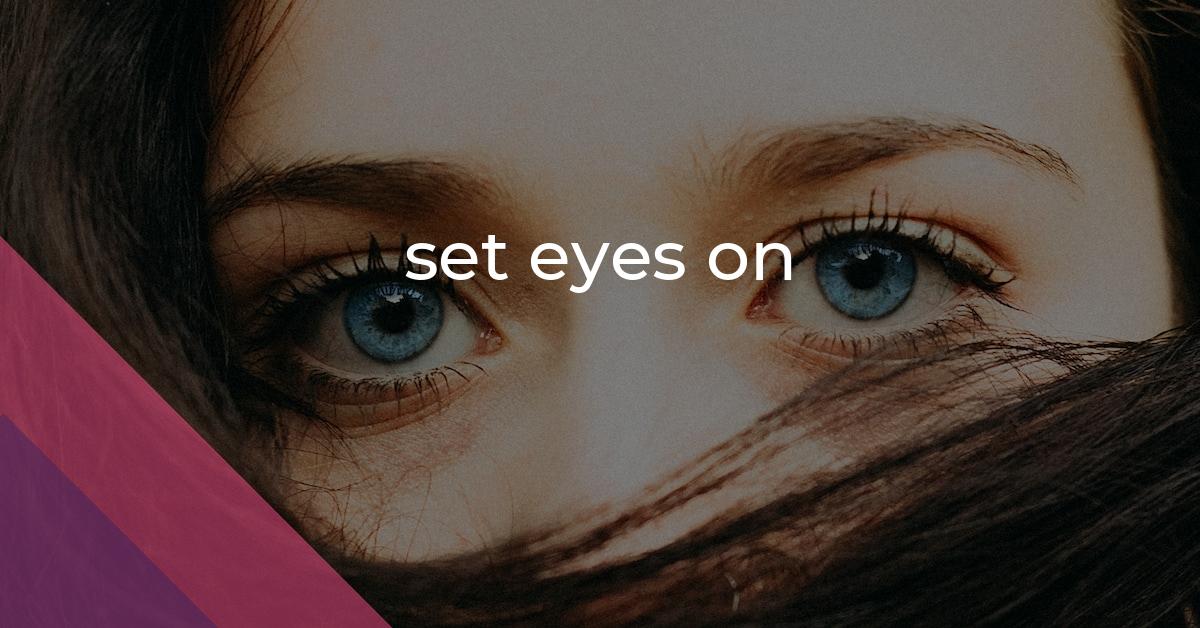set eyes on: Idiom Meaning and Origin
What does ‘set eyes on’ mean?
The idiom "set eyes on" means to see or look at something. It implies a strong desire or curiosity to see something or someone for the first time.

Idiom Explorer
The idiom "take one's eye off the ball" means to lose focus or become distracted from an important task or goal.
The idiom "take a look" means to examine or observe something briefly or quickly.
The idiom "take a gander" means to take a quick look or glance at something. It is often used informally to suggest a casual or casual observation.
The idiom "stink eye" refers to a disapproving or scornful look, often accompanied by a glare or intense gaze. It is typically used to convey strong negative emotions or to show extreme contempt or displeasure towards someone or something.
The idiom "steely-eyed" means to have a determined and focused gaze, typically indicating resolve, determination, or intensity.
The idiom "steal a glance" means to quickly and discreetly look at something or someone, often when it is not socially acceptable or appropriate to do so.
"Stars in one's eyes" is an idiom that means to have a sense of excitement, wonder, or idealism. It is often used to describe someone who is overly optimistic or has unrealistic expectations about something.
The idiom "stare someone in the face" means to confront or face a difficult or uncomfortable truth directly, without avoiding it. It implies looking someone or something directly in the eye, without flinching or turning away.
The idiom "sight unseen" means to make a judgment or decision without seeing or examining something or someone beforehand.
FAIL
The idiom "set eyes on" is a common English expression that refers to the act of seeing something or someone for the first time. It conveys a sense of the initial encounter or the first direct visual contact with a person or object. The idiom often implies surprise, wonder, or admiration associated with the sight or appearance of the subject.
When analyzing the meaning of the idiom "set eyes on," it is essential to consider its literal interpretation. The phrase originates from the literal act of setting one's gaze upon an object or an individual, indicating the beginning of visual perception. This literal understanding forms the basis of the idiom's figurative implications.
Action verbs such as "set" and "eyes" in the idiom compound the significance of the expression. "Set" suggests intentionality or purposefulness, emphasizing the deliberate action of positioning one's gaze towards a specific point. "Eyes" in this context signifies the visual organs and represents the sense of sight.
The idiom "set eyes on" is often used in the past tense, as in "set eyes on." This usage denotes a particular moment of seeing that has already occurred, encapsulating the experience of the initial encounter or discovery. It may imply a degree of rarity or significance, emphasizing the impact of the visual experience on the beholder.
Furthermore, the idiom "set eyes on" can also function as a metaphorical expression. It can communicate the emotional effect or impression that something or someone has on an individual upon first sight. This metaphorical usage emphasizes the powerful and immediate effect that the visual perception can have on a person's thoughts, feelings, or overall perception of a situation.
The idiom "set eyes on" holds cultural relevance, appearing in various literary works, oral traditions, and everyday conversations. Its usage is not limited to any specific domain, making it a versatile expression across different contexts and settings. Additionally, the idiom's simplicity and widespread familiarity make it a valuable tool in communication, facilitating concise and evocative descriptions of personal experiences related to seeing.
The related idiom "lay eyes on" has a similar meaning to "set eyes on." It also signifies seeing something or someone for the first time, but with a stronger emphasis on the act of physically placing one's eyes upon the subject. The phrase "lay eyes on" suggests a more deliberate or intentional action, as if someone is consciously directing their gaze towards the object of interest.
The idiom "clap eyes on" is another related expression that shares the meaning of seeing something or someone for the first time. However, it conveys a sense of suddenness or surprise. The phrase "clap eyes on" suggests a more abrupt or unexpected sighting, as if the subject of interest appears suddenly or unexpectedly in one's line of sight.
The idiom "give someone the eye" relates to "set eyes on" in the sense that it involves looking at someone with romantic or flirtatious intent. While "set eyes on" generally refers to any initial encounter, "give someone the eye" specifically implies an intention to show interest or attraction. It can involve a subtle or overt visual gesture, such as a lingering gaze or a flirtatious glance.
The idiom "set eyes on" encapsulates the act of seeing something or someone for the first time. Its literal interpretation pays homage to the initial encounter and the beginning of visual perception. The idiom's figurative implications capture the emotional impact and significance of the visual experience. Its versatility and cultural relevance solidify its place in the English language, allowing speakers to concisely convey the power and effect of first impressions. Through its rich history and continued usage, "set eyes on" remains a captivating idiom that invites exploration and appreciation of the nuanced art of communication.
Example usage
Examples of how the idiom *set eyes on* can be used:
- I couldn't believe my luck when I first set eyes on the breathtaking view from the mountaintop.
- As soon as she set eyes on the adorable puppy, she knew she had to adopt it.
- He fell in love with her the moment he set eyes on her elegant and graceful dance performance.
More "Perception" idioms



